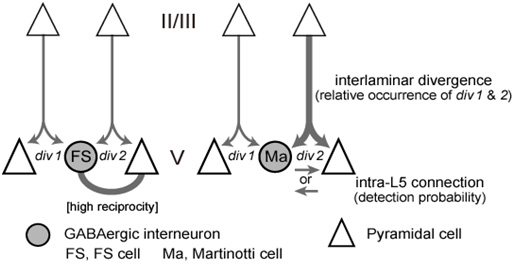The neocortical circuit is composed of excitatory principal neurons and inhibitory interneurons. Recent advances have established that multiple subnetworks of synaptically coupled excitatory neurons provide distinct pathways for information flow through the cortical circuit. Here we have investigated how inhibitory interneurons are incorporated into these excitatory subnetworks in the rat frontal cortex. In layer 5 (L5), the probability of reciprocal synaptic connections between pyramidal cells and fast spiking (FS) interneurons was significantly higher than the probability of reciprocal connections between pyramidal cells and non-FS interneurons. Further, the amplitude of synaptic currents in reciprocally connected FS/pyramidal cell pairs was larger than that in pairs connected only in one direction. To examine interlaminar connection specificity, we stimulated layer 2/3 (L2/3) pyramidal cells, using focal glutamate puff stimulation, and recorded evoked EPSCs in L5 cells. Stimulation of L2/3 cells evoked EPSCs in L5 non-FS cells more frequently than in L5 FS cells. Dual recordings from L5 interneurons and neighboring pyramidal cells revealed that connected non-FS/pyramidal cell pairs were more likely to share excitatory inputs from L2/3 cells than were unconnected cell pairs. On the other hand, the connectivity between L5 FS and pyramidal cell pairs did not affect the common input probability from L2/3. Our results suggest that L5 inhibitory interneurons form distinct intra- and interlaminar subnetworks with pyramidal cells, depending on inhibitory cell types.

Schematic diagram of intra- and interlaminar subnetworks of pyramidal cells and interneurons. Line thickness represents connection probabilities. Triangles and circles indicate pyramidal cells and interneurons, respectively.